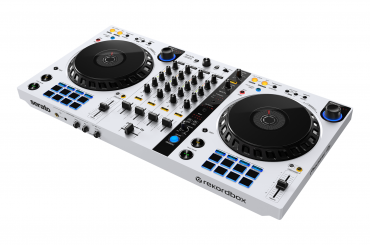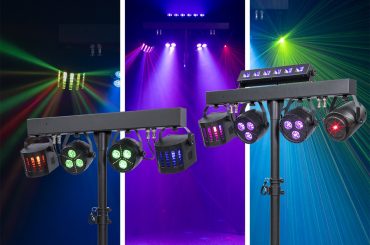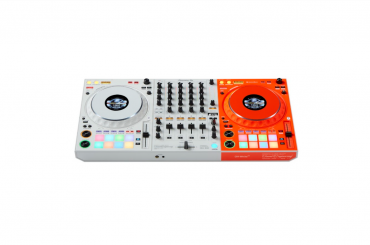Building a Home Studio Requires Some Attention to Detail, But Not as Much Money as You Might Think
There’s no question that the music industry has, in the last decade or so, changed dramatically.
On one front, music distribution has changed markedly in the post-original-Napster era, and the shift from physical to digital is now quite well- established. (Along with it, the monetary value of recorded music in the eye of the consumer has declined markedly as well, but that’s a topic for another article, another day.) Distribution has also been fully democratized; anyone who wants to sell a track on iTunes (or Google Play, or Amazon.com, or…) can now do so with a minimal price for admission.
But production—more the subject of this article—has also been democratized. While the gear still requires an investment and the means to make that investment, creating the so-called “garage band” and producing music has never been more within the reach of the masses.
For those of us in the EDM world, the term “garage band” might not apply, but the principles are much the same, and in this article, I take a look at what’s involved in putting together a respectable, functional home studio from the ground up.
My motivation? While I’ve been a musician for most of my adult life, it was just six short years ago that I assembled my first commissioned EDM remix. In the years since, I’ve been commissioned here and there to do more, but it was last fall that I released my first track under my own name (a remake of the ’80s classic “I Love My Radio,” with vocals from Carol Hahn). To celebrate, I decided I wanted a better studio than my home office, with its less-than-ideal, all-hard-surfaces, shared focus. This article documents the journey of setting one up.
Choosing a Location
For most of us, space is always at a premium. Whether you rent or own also enters into the equation, as does whether or not your walls are shared with your neighbors. Thankfully, a decent home studio doesn’t really require a ton of space, but it does require a balancing act of compromise between what you have available, what’s the least likely to bother others (in your own home, or your neighbors, as applicable), as well as which space has the optimal acoustic qualities. There is almost never an ideal combination, unfortunately.
Aside from other considerations, the ultimate goal is to have a space where audio reflections are minimized. Hard surfaces allow sound waves to bounce around, which will skew your perceptions of your recordings and make leveling and mastering difficult. As a result, you want soft surfaces—not hard ones. So to the extent possible, choose your space accordingly. Avoid hard wood or laminate flooring in favor of carpet, or at least soft, thick rugs vs. bare, hard surfaces. Upholstered chairs or sofas also help, as can fabric window coverings (like thick curtains instead of blinds, for example).
Few of us have the ability to truly dedicate space on a permanent basis to home studio. If you’re one of those who do have that flexibility, installing acoustic foam panels (available online or from music stores) can help acoustically deaden a space. Unless you’ll be recording vocals or live instruments, fully deadening a space is not necessary, and for those of us who have to make the home studio part of a greater living space, it’s a balance of technical needs and aesthetics.
For my own studio, the aesthetics trumped other considerations, so acoustic foam panels were not really an option. I chose instead to try my best to nullify hard surfaces with decorating choices involving lots of “soft stuff.”
Another aspect of location choice is electrical power. Thankfully, the typical home studio just doesn’t need much actual amperage capacity in most cases; it’s more a matter of sufficient outlets. I’ll talk more about that later, but make sure that there’s at least one outlet pair in close proximity—ideally one that’s not shared on a circuit with noise-generating appliances like fans, microwave ovens, etc.
Building a Workspace
The amount of workspace you need depends on a number of factors, but given that the typical home studio is a computer and computer monitor, some audio gear, maybe a small keyboard, and a pair of studio monitors (speakers), for most of us, a main work surface or desk 5- to 6-feet wide is sufficient, assuming the monitors will sit on top of it. (Using floor stands will reduce the desk size needs.)
Music gear retailers have any number of off-the-shelf options available. One of my producer/musician friends here in Denver assembled his workspace using commercially available glass-top desk units with metal “Z” legs, and the result is aesthetically striking.
In my own case, I wanted a work surface, some desk drawers, shelves for manuals and other “stuff,” and space to one side for a double deck of a MIDI keyboard and a synthesizer. While I looked for ready-made workstation options, I wasn’t happy with either the available options—or the prices (as a notorious cheapstake). As a result, I went with a DIY approach fueled by my local IKEA store.
The work surface is a NUMERÄR kitchen countertop, used without cutting (roughly 73-inches wide x 25-inches deep). To support it, I used height-adjustable VIKA KAJ desk legs (to allow it to sit level with only the front two legs on a rug; the back paid on the hardware floor underneath—while providing flexibility in overall height choice). Desk storage came via a MICKE drawer unit, while shelves came via an EXPEDIT shelving unit with a couple of DRÖNA boxes, enabling me to store cables and other stuff out-of-sight on two of the shelves.
To add a sturdy keyboard tray, I turned to Rockler (a national chain of woodworking supply stores) for the sliding tray hardware, combined with a standard black, laminated shelf (from the local Home Depot). And to create a system to elevate my computer monitor to ergonomic height, and the studio monitors to ear height, I borrowed some ideas found online, and used still more IKEA parts. CAPITA legs, in brushed stainless steel and available in 4-, 6-, and 8-inch heights, are normally for another purpose, but make an ideal choice for building your own elevated work surfaces when combined with shelving, either as-is, or cut to size. I did some measurements of my needs, drafted a plan on paper, determined size and positioning for cuts and holes, and then using EKBY HEMNES shelving, custom-made an adjustable desktop-stand system in a couple of weekend hours.
Finally, the keyboard and synth are situated along the right side of my work area on standard metal stands available from any major music gear retailer. Lighting choices (also IKEA) completed the workspace, along with an existing Herman-Miller Mirra office chair (comfort and adjustability justify the investment in a premium product here, in my view).
The point here is to pick something that works for you, and not to rule-out some creative DIY to tailor the result to your space, needs, preferences, and budget.
Choosing & Adjusting the Gear: Monitors
Which gear you choose is largely a factor of your workflow and individual needs and preferences. At a minimum, of course, you’ll need a decent pair of professional-grade near-field studio monitors to hear your work, positioned optimally. (I’ll talk more about that in the next section.) In my personal view, monitors with 8-inch main drivers are an ideal choice. Of course, you can pick something larger if you have the space, and you’ll get a tad more low-end from them if you do.
It’s not a place to skimp in your investment, in any case; high-quality monitors are a one-time investment worth making if you’re serious about your studio, and you can expect to lay out around $500 each for them typically—sometimes more.
Most monitor series from most manufacturers also have optional sub-woofers available. Whether you choose to have one is a personal choice, but I’ve found that they can skew mixing and mastering if not leveled properly, and doing proper leveling is difficult at the very low end of the frequency spectrum, where sound waves propagate differently than higher up in the audible range.
Not only is tuning a sub challenging, but so is adjusting the top monitors. Trained audio engineers might be able to make more skilled judgment calls, but those of us who lack that training have to make do. Listen to a wide range of familiar material once the studio is fully set up and everything in place. Does the audio sound bright? It probably is; use back-of-monitor adjustments to reduce the high-end. Does it pound like a nightclub on a Saturday night? Turn down the sub to a more modest level to avoiding skewing your mixes.
Room-tuning devices (a couple of which I’ve reviewed in past issues of DJ Times) can be helpful here, but don’t discount using your ears.
One of the clearest ways to know something’s not right is simply to try an informal mastering job in your new studio, leveling and EQing carefully until you’re satisfied with the result, then listening to that result in as many listening environments as you can (home stereos, headphones, ear buds, in your car, etc.). Is it harsh? Is there too much low-end? What you hear provides plenty of clues to the adjustments you may need to make to your studio listening environment. Just remember that things work backward, so to speak; are your mixes consistently a bit dull, sonically speaking? The reflectivity of the listening environment may be accentuating the high-end in your studio, causing you to cut those frequencies too much in your mix. Tame the high-end in the studio listening environment, and the net result will likely be a brightening in your mixes as you attempt to make your own ears happy. Similarly, inadequate low-end punch can be caused by having your sub turned-up too high (or the low-end on the top monitors not adjusted properly).
Choosing & Adjusting the Gear: The Rest
Once the monitors are out of the way, the other items that make-up your home studio depend almost entirely on needs and preferences.
On the computer front, in my own case, I decided I wanted the ability to work on music on-the-go, as well as in the studio. To that end, a notebook computer—not normally associated music production, perhaps—was my computer of choice; in my case, a tiny little 13-inch MacBook Pro with plenty of memory and a solid-state hard disk. When sitting in the studio, it’s connected to an Apple Thunderbolt display, which provides power, lots of screen real estate, as well as network, USB and other connections. Essential USB devices (such as my audio interface) are connected directly to the USB ports on the Thunderbolt display, while secondary USB devices go to a separate USB hub (see below). The end result has proven itself in terms of performance; you may prefer a traditional desktop system.
One noteworthy item to talk about is the audio interface. If you’ve not invested in a decent, professional-grade audio interface before now, the build out of your studio is a great time to do it. I, as well as my colleagues here at DJ Times, have reviewed scores of audio interfaces over the years, and there are myriad choices across myriad budgets.
Beyond the overall quality, as it pertains to your new home studio, choose something with the inputs and outputs you need to support your workflow. On the output side, a pair of stereo outs is nearly essential—one for your monitors, one for headphones. Many producers find that support for two pair of monitors is useful (which means finding a place for a second set on the worktop as well), allowing A/B comparison in-studio.
But beyond output, get the inputs you need. Recording vocals? Live instruments? If so, by instrument cable, or mic? Running external synths? For my own needs, one stereo monitor out, one stereo headphone out, and a pair of mono, switchable inputs (which can, of course, be used as a single stereo input if I wish) was sufficient. I can switch those two inputs among four different pairs of physical connections, and given that I’ll be using them only one at a time, it meets my needs just fine.
As mentioned earlier, electrical needs are a key consideration. Total power draw isn’t the issue—“clean,” noise-free, surge-free power is. Music retailers have an array of power distribution systems that help address both the noise issue as well as the “number-of-places-to-plug-things” issue. Better quality UPS units (uninterruptable power supplies) often address noise filtration in addition to the benefit of taming of surges, brown-outs, and letting you ride through brief black-outs. I personally choose the UPS route.
As for everything else—computer, computer monitor(s), USB hubs, etc.—there’s little to say other than making sure you have a place for the stuff you need and use.
Neatness may or may not truly count, but the build out of my new studio was an excuse to pull out a couple of rolls of hook-and-loop tape and tidy up all the cabling between and among all the gear, resulting in a finished product that, aesthetically-speaking, is a source of pride every time I sit down to work on music, or host the occasional visitor here at home.
Summary
Price-wise, it totalled $6,640, breaking down like this:
Furniture and Lighting: $420
Chair: $850
Basic Studio Gear (monitors, I/O, etc.): $2,000
DAW (Ableton Suite): $750
Computer Gear (Apple): $2,620
Building out a home studio is not rocket science, but some attention to the proper details, coupled with the right mix of commercially available (and, perhaps DIY) components can help you achieve optimal technical results. And while possessing a nice home studio won’t itself catapult you to stardom, it might very well help foster creativity and put you in the right mindset to help make it happen.
[button_2 color=”#ff0011″ size=”button-med” icon=”none” text=”Read More From This Issue” link=”http://viewer.zmags.com/publication/20ad5266#/20ad5266/4″]








